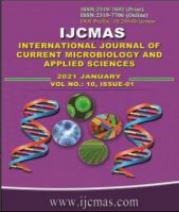


 National Academy of Agricultural Sciences (NAAS)
National Academy of Agricultural Sciences (NAAS)

|
PRINT ISSN : 2319-7692
Online ISSN : 2319-7706 Issues : 12 per year Publisher : Excellent Publishers Email : editorijcmas@gmail.com / submit@ijcmas.com Editor-in-chief: Dr.M.Prakash Index Copernicus ICV 2018: 95.39 NAAS RATING 2020: 5.38 |
Fieldpea is an important rabi pulse crop grown throughout India. The Cluster front line demonstration on field pea variety Prakash was conducted by Krishi Vigyan Kendra Nagaon during the period from 2015-16 and 2018-19 in sixteen to eighteen villages in Nagaon district under central Brahmaputra zone by the active participation of farmers with the objective of popularizing improved technologies of field pea among the farmers. The results of demonstration showed that farmers could increase the field pea productivity notably by switching over to improved variety and adoption of good agriculture practices. Existing farmers’ practices were treated as control for comparison with demonstrated practices. The results revealed that the demonstrated plots recorded an average yield ranging from 6.21– 7.93 q/ha with an average of 7.15 q/ha whereas in Farmers practice it ranged between 4.48 to 5.6 q/ha with an average of 5.08 q/ha. The per cent increase in demonstration yield over the farmers’ practice during 2016-17 to 2018-19 was 35.71% to 46.30% respectively. The extension gap and the technology gap was ranging between 1.73 to 2.51q/ha and 10.30 t0 12.02 q/ha. The technology index was 56.50 to 65.93 % during the period under study. The results highlighted the fact that field pea production on rice fallows through adoption of recommended technologies which were followed in the CFLDs can be encouraging to our farmers and thereby paving the way towards increasing cropping intensity in mono-cropped areas.
 |
 |
 |
 |
 |